With Windows 11/10, Microsoft has tried to make the PC experience easy and clutter-free for its users. It has many auto-optimizing features to make your PC run smoother. Still, you must know some basic computer optimization tips to improve Windows 11 performance and make your computer work efficiently.
It doesn’t matter how fast or shiny computers might be when they’re new; they all seem to get slower over time. That state-of-the-art PC you bought last year might not feel like such a screamer after you install a dozen programs, load it with antispyware and antivirus tools, and download untold amounts of junk from the Internet. The slowdown might happen so gradually that you hardly notice it until one day, you’re trying to open a program or file and wonder, “What happened to my PC?” This slowdown is called Windows Rot; although Microsoft has done a lot to reduce this since Windows Vista.
Optimize Windows 11/10 for better performance
Whatever the cause, there are many ways to help speed up Windows and make your PC work better, even without upgrading your hardware. Here are some very easy and basic tips to help you Tune-up Windows and optimize it for faster performance:
- Use Performance Troubleshooter
- Remove programs you never use
- Manage your startup programs
- Defragment your hard disk
- Use Disk Cleanup to clean Hard Drive
- Run only the necessary programs at the same time
- Turn off Visual Effects
- Restart your PC occasionally
- Add more Memory
- Check for viruses and spyware.
1] Use Performance Troubleshooter
The first thing that you can try is the Performance troubleshooter, which can automatically find and fix performance problems. The Performance troubleshooter checks issues that might slow down your computer’s performance, such as how many users are currently logged on to the computer and whether multiple programs are running simultaneously. To run the Performance Troubleshooter follow these simple steps:
Open ControlPanel > All Control Panel Items > Troubleshooting
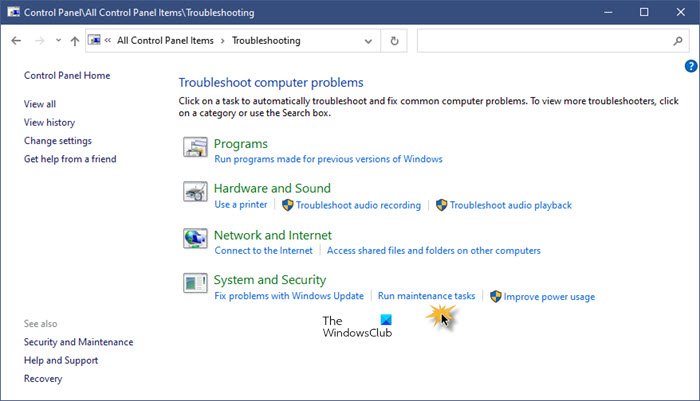
Click on Run maintenance tasks to open the Performance Troubleshooter.
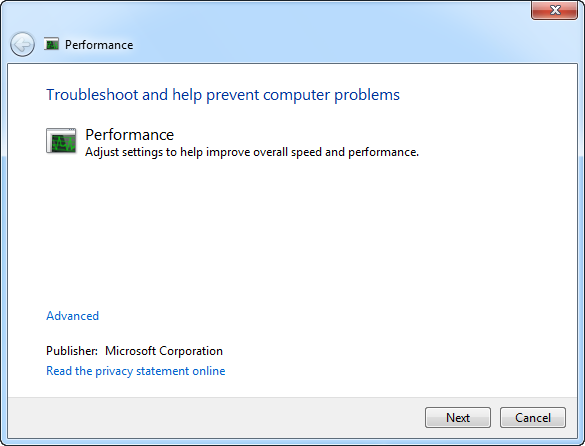
Follow the steps available in the wizard to fix the performance-related issues.
2] Remove programs you never use
Many PC manufacturers pack new computers with many unwanted software which you may never use. These are often limited versions or trial versions of software or crapware which are, after a certain time period, have no use. Utilities and programs installed by you may have no use, as many software are bundled with lots of unwanted options like toolbar, registry scanners, web browsers. Keeping unwanted and useless software installed can have an adverse effect on PC performance, and so it’s better to uninstall them and save disk space.
3] Manage your startup programs
Many programs are designed to start automatically when Windows starts. Software manufacturers often set their programs to open in the background, where you can’t see them running. That’s helpful for programs you use a lot, but for programs you rarely or never use, this wastes precious memory and slows down the time it takes Windows to finish starting up.
To manage your startups, Windows 11/10 users need to open the Task Manager > Startup tab.
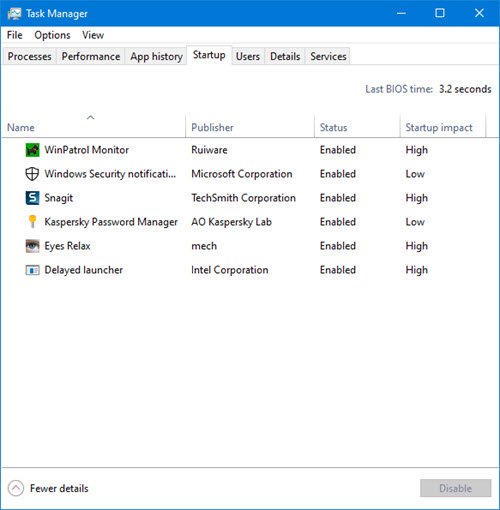
Highlight the entry and right-click and select Disable/Enable.
Windows 7 users can use the System Configuration utility.
- Click on Start and type MSCONFIG in the search bar.
- Open it and click on the Startup tab.
- Unchecked the entries, which you’ll find unnecessary to run at Windows Startup.
- Click Apply and OK to save the settings and then restart your PC.
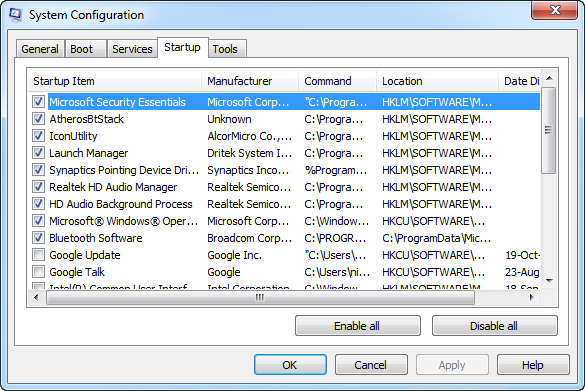
Read: How to stop Background Processes in Windows 11
4] Defragment your hard disk
Fragmentation makes your hard disk do extra work that can slow down your computer. Disk Defragmenter rearranges fragmented data so your hard disk can work more efficiently. Disk Defragmenter runs on a schedule automatically, but you can also defragment your hard disk manually. To use Windows inbuilt Disk Defragmenter utility, navigate to Accessories folder in Start menu, then click on System Tools and run Disk Defragmenter.
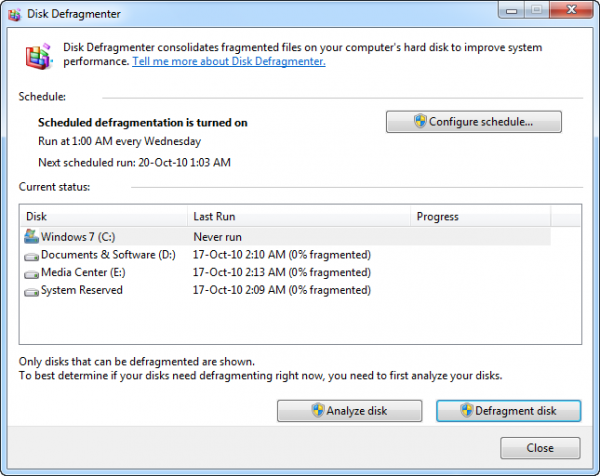
There are several other free Disk Defragmentation software that you can make use of.
5] Use Disk Cleanup to clean Hard Drive
Unnecessary files on your hard disk take up disk space and can slow down your computer. The Disk Cleanup Utility removes temporary files, empties the Recycle Bin, and removes a variety of system files and other items that you no longer need. To use Disk Cleanup, follow these steps:
- Open Computer, Right-click on Hard Disk partition for which you want to run Disk Cleanup.
- Then click on the Disk Cleanup button. It will take some time to start as it will analyze for Junk files.
- Check the boxes for files which are useless and click Ok.
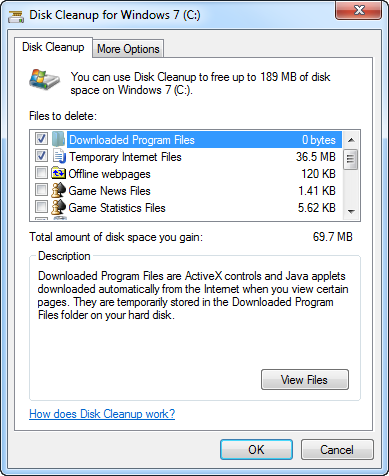
CCleaner is my personal favorite for junk cleaning.
6] Run only the necessary programs at the same time
Many times, we keep on running several programs at the same time, and more often half of them remain open without any use. Sometimes changing the behavior of using your PC also benefits in gaining better performance. If you find your PC slowing down, ask yourself if you need to keep all your programs and windows open at once. Find a better way to remind yourself to reply to email messages rather than keeping all of them open. Make sure you’re only running one antivirus program. Running more than one antivirus program can also slow down your computer. Fortunately, if you’re running more than one anti-virus program, the Action Center notifies you and can help you fix the problem.
Read: How to maintain Windows in good running condition.
7] Turn off Visual Effects
If Windows is running slowly, you can speed it up by disabling some of its visual effects. It comes down to appearance versus performance. Would you rather have Windows run faster or look prettier? If your PC is fast enough, you don’t have to make this tradeoff, but if your computer is just barely powerful enough for Windows 10/8/7, it can be useful to scale back on the visual bells and whistles.
You can choose which visual effects to turn off, one by one, or you can let Windows choose for you. There are 20 visual effects you can control, such as the transparent glass look, the way menus open or close, and whether shadows are displayed.
To adjust all visual effects for best performance:
- Right Click on the Computer icon and click on Properties.
- In the left pane, click on Advanced Settings. If you’re prompted for an administrator password or confirmation, type the password or provide confirmation.
- Click on settings in performance and then check or uncheck options to adjust for best performance and then click OK. (For a less drastic option, select Let Windows choose what’s best for my computer).
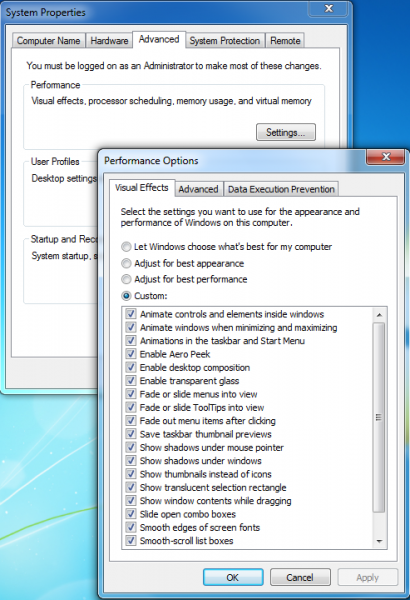
8] Restart your PC occasionally
This tip is simple. Restart your PC at least once a week, especially if you use it a lot. Restarting a PC is a good way to clear out its memory and ensure that any errant processes and services that started running get shut down. Restarting closes all the software running on your PC, not only the programs you see running on the taskbar but also dozens of services and drivers that might have been started by various programs and never stopped. This step refreshes your Windows OS.
Read: How to fix Performance issues in Windows 11.
9] Add more Memory
This isn’t a guide to buying hardware that will speed up your computer. But no discussion of how to make Windows run faster would be complete without mentioning that you should consider adding more random access memory (RAM) to your PC.
If a computer running Windows seems too slow, it’s usually because the PC doesn’t have enough RAM. The best way to speed it up is to add more. Windows 7 can run on a PC with 1GB of RAM, but it runs better with 2 GB. For optimal performance, 3 GB or more would be preferred. Another option is to boost the amount of memory by using Windows ReadyBoost.
TIP: You can use Windows Boot Performance Diagnostics to detect Windows Boot Performance problems.
10] Check for viruses and spyware
If your PC is running slowly, it’s possible that it’s infected with a virus or spyware. This is not as common as the other problems, but it’s something to consider. Before you worry too much, check your PC using antispyware and antivirus programs. A common symptom of a virus is a much slower-than-normal computer performance. Other signs include unexpected messages that pop up on your PC, programs that start automatically, or the sound of your hard disk constantly working.
Spyware is a type of program that’s installed, usually without your knowledge, to watch your activity on the Internet. You can check for spyware with Windows Defender or other antispyware programs. The best way to deal with viruses is to prevent them in the first place. Always run antivirus software and keep it up to date. Even if you take such precautions, however, it’s possible for your PC to become infected.
Windows 11 can boost system performance. It optimizes resource allocation by focusing on foreground apps and minimizes background processes. This streamlined approach can enhance system efficiency, especially on PCs with limited RAM and CPU capabilities, resulting in a smoother user experience.
To increase boot speed in Windows 11, disable unnecessary startup programs via Task Manager, optimize your drive using the ‘Defragment and Optimize Drives’ tool, and ensure Fast Startup is enabled in Power Options. Also, upgrading to an SSD and increasing RAM can significantly enhance boot times.
Want more?
- How to make Windows Start, Run, Shutdown faster may interest Tweak enthusiasts!
- You might want to also read our Basic Windows Troubleshooting Tips for Beginners.
I have a real problem trying to keep myself from leaving programs or folders open. I usually find myself with roughly 12 to 20 folders open mostly due to not remember what they were if I close them. Is there a way to save ‘sessions’ of file explorers or is there a better ‘favorites’ thing? Maybe something in the style of a browser bookmark system?
I’d love for something better than favorites and library and to me, I think that would be a browser style bookmark tree on the side or a session manager. I’ve tried alternatives to the default file explorer in windows 7 but I haven’t found any that I like; they all feel very cluttered and have too many extra features but lack basic ones such as specific thumbnails views (small, medium, large) list view, etc.
Programs that I leave running I could certainly trim down on though. Thanks for the helpful article.
install a RAM-disk.
move your browsercache & tempfiles to it.
makes a BIG difference especially with an old computer with IDE-disk.
see my post at TWCF:
http://forum.thewindowsclub.com/windows-7-management-support/31075-few-tips-about-windows-performance-etc.html?
update to my comment above:
install your operating system, programs and pagefile on separate partitions.
see my post at TWCF:
http://forum.thewindowsclub.com/windows-7-management-support/31075-few-tips-about-windows-performance-etc.html?
Chkdisk at least monthly using both parameters available in C: drive PRPOERTIES ->TOOLS ->DISK CLEANUP
Thanks for this helpful information.I also felt this kind of problem many times.Please go through http://www.knowurpc.org to get more information on this topic.
Great tips. For beginers I also would highly recommend downloading and running AdwCleaner – it gets rid of the most common crapware, malware, search hijackers and useless toolbars in just a few clicks. PCdecrapifier is also another great tool – use it for batch uninstalling unwanted programs. Lastly, if you are not already – start using Google Chrome as your default web browser, install the adons WOT & Adblock, and configure your computers network adapters to use Google’s DNS.
Microsoft has MRT.exe already installed! Malware Removal Tool scans and repairs malware for free! Go to your search window or command line and type MRT or MRE.EXE
True, but it is not exhaustive and searches for only select malware. The Microsoft Safety Scanner gives a full scan: https://www.thewindowsclub.com/microsoft-releases-microsoft-safety-scanner-an-on-demand-antivirus-tool :)
What is the difference between restarting your computer and simply shutting it down and then starting it again, as far as clearing out its memory and ensure that any errant processes and services that started running get shut down?
Both options should achieve the same result.
Increasing your ram will give your PC the ability to multitask and you will see huge performance gains. 4gb is minimum on any Win 7 machine. 2gb is pathetic. With today’s cheap ram prices there is no reason to run less than 4gb but even 8gb isn’t overkill.
If you have a SSD there’s no need to defragment it, because a SSD can access any location on a drive at the same time. If you defrag anyway your drive will reduce performance.
@Dave have your tried Total Commander? You’ll have a dual pane view and you can open different drives on each pane. You can also view thumbnails or a tree view.
I always follow the above steps to clean the computer but doing it manually takes more time. So, I prefer computer cleaning software like Ninja TuneUp which helps to clean all the crap files in minutes.
Why would i have performace issues with my:
64bit asus. 32gig ram, ssd for apps & OS, i7 x 8(4real)processors. win10pro, up to date security, running minimum tasks/software at once etc etc.. never peaking ram, though CPU & disk (mostly CPU) often peak & generally get intermittent gui freezes e.g. not responding if click too quick (from one thing to the next).
my question is, what common places, logs should i check (and of course where i know what to look for within logs, or settings)
i only ask as i have looked at all the menu based/control panel options etc. and have reduced everything with performance in mind….
suggestions please please?